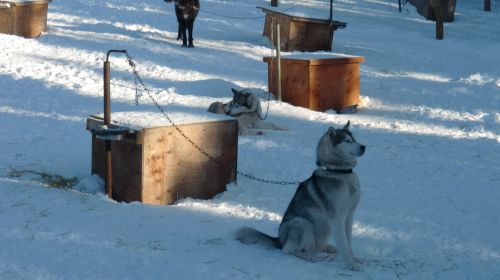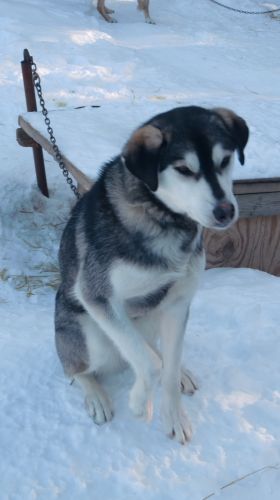I was fortunate enough to be able to spend a few extra days in the Fairbanks area after orientation wrapped up. My husband Ethan came up to join me and partake in various Alaskan winter adventures. We took on some cross country skiing, went to Denali National Park for a drive and hike, checked out Chena Hot Springs, and best of all...learned to mush!
Mushing School
A Brief History
Dog sledding is a very popular sport in northern latitudes. It was originally used for transportation of people and goods to in accessible locations- they've even been used to deliver the mail to rural communities! There are various breeds of dogs used in dog sledding each offering its own benefits. Some are better at pulling heavy loads, others have better endurance. Today recreational dog sledding is the main use in Alaska. There are famous races such as the Iditarod and Yukon Quest held each year.
Care for the dogs
We attended mushing school at Sirius Sled Dogs located outside of Fairbanks. Nita and Josh are the owners of Sirius and have a dog handler named Garrett. They have a team of 20 dogs currently, though this fluxes given puppies added and retired dogs. Mushing school begins with a tour and explanation of dog care, showing us their food, treats and tricks for hydration.
 Dog yard at Sirius Dog Sleds
Dog yard at Sirius Dog Sleds
The dogs each have their own little house with fresh straw to lay on. They don't keep water in their bowls since it would freeze, and licking a block of ice is no fun! They have worked out ways to ensure the dogs stay hydrated however. Their dry kibble is soaked to have it absorb water before they are fed. Also following a run many of the dogs come inside to drink from a water bowl that isn't frozen. Those that don't come inside are brought a small amount of water to their houses to drink before it freezes. These dogs burn tons of calories- it has been calculated that a racing team (like in the Iditarod or Yukon Quest) will burn 240 calories per pound per day during the race. For a 50 pound dog that's 12,000 calories per day!
They also make a tasty treat to add extra calories and water. At the end of the salmon runs they collect the chum salmon- the salmon that have already spawned and are dying off. These chum aren't good for human consumption, but are a tasty treat for the dogs! They freeze the salmon on skewers as the outdoor temperature drops. When they are ready to make a popsicle they chop up three of the salmon and boil it, making a fishy soup. This soup is poured into trays and frozen. These little cubes make for a yummy snack for the dogs when out on a run. Other treats involve dog biscuits probably much like you feed your dog, and frozen chicken skins.
When out on a run dogs often eat some snow for a little hydration either while on the run or during a break. They also love to roll in the snow!
 Sled dog
Sled dog
The dogs are clearly well loved. They are checked for how they are maintaining weight, and are given extra food if needed- or if something else is going on (like a rotting tooth causing them to not eat) they will take the dog to the vet to get checked out. The dogs curl up in their houses and seem to stay quite toasty! They love the colder temps of winter. There are a few dogs that sleep in the house with the humans- either due to age, illness, preference or whining! They're sure hard to say "no" to when they want to snuggle.
On trail mushers will carefully watch their team looking for any sign of injury or discomfort. Either adjusting the harness or massaging a sore foot, shoulder, leg etc. If the dogs are well cared for they make for a strong team, which is what all mushers want. These dogs truly become their life and their family.
Stay tuned to learn more about the conditioning and mushing school experience!

